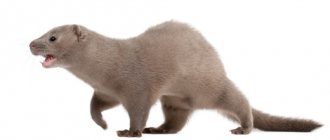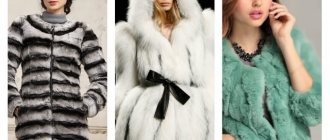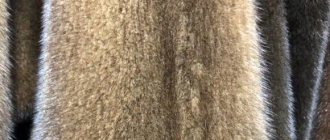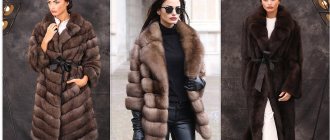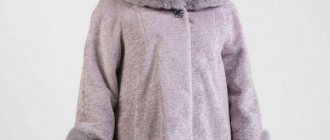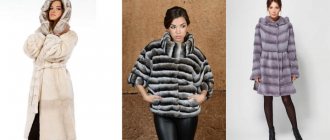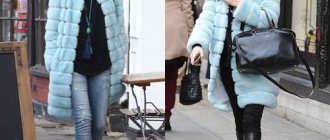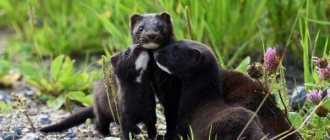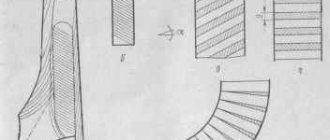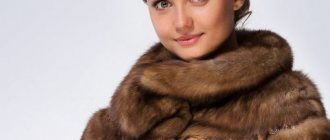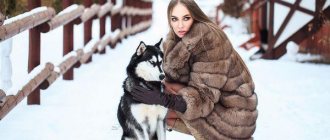When choosing a mink coat, the determining factor, of course, is its quality. To buy a truly high-quality product that will last for many years, and at the same time will not lose its good appearance and high performance characteristics, you should know several rules for determining the quality of fur. This will allow you to figure out what is being offered to you already in the store, and not buy a cheap fake, passed off as an elite-class product, of which there are many in the world of fur, and especially mink due to its popularity, today.
What is mezdra?
How to correctly evaluate the quality of mink fur
The quality of a mink coat is primarily determined by the quality of its fur. The following rules apply:
1. The fur should not be dull, thin, brittle, or have a bitter smell - all these are signs of old age. That is, in front of you, at best, are the remnants of the collection from the year before last, or (at worst) an altered fur coat from the last century. Don’t take it even with a 50% discount, as you may be left with nothing immediately after the first severe frost - old fur is very afraid of temperature changes. It also happens that fur loses its visual appeal due to improper storage conditions or after artisanal processing.
2. Natural mink hairs easily return to their natural position , so if you run your hand “against the grain,” the fur should literally immediately return to its original form. If the hairs become sticky, tangled, or simply look untidy, you have either a fake or an original, but low-quality mink. Also, during physical impact, the fur should not fall out or break, so you can calmly shake the fur coat and lightly pull the material at the base.
3. It is important that the fur is the same length over the entire area of the fur coat - this means that the skins are approximately the same in age, and are also properly dressed and sewn. Inexpensive products cannot boast of such a feature as authentic fur, so second-rate mink coats most often undergo shearing, after which the pile loses its natural softness and becomes prickly.
4. Don’t forget to look closely to see if there is a thin little “fluff” at the base of the long fibers . This is the so-called undercoat, which is precisely the key to the good heat-saving properties of natural mink. It contains a large air layer that will prevent you from freezing and make your fur coat fluffy. The absence of a thick undercoat casts doubt on the origin of the fur and should be a wake-up call if you want to spend money on a real mink rather than a cheap fake.
5. The type of fur must be indicated on the label or tag . The phrase “100% fur” speaks for itself - no one guarantees that the skin belongs to a noble mink and not to a marmot.
Possible defects
You can avoid buying a fake if you know the common defects in mink fur. This should include:
- Uneven fur color, fading, abrasions. All these flaws indicate that old and low-quality fur was used for sewing.
- Don't know how to check quality? Then inspect the fur coat for red spots. If they are true, then this indicates that the animals were kept in iron cages. Rest assured that it is simply impossible to get rid of such stains.
- The fur fibers stick together, there is no gloss or shine. These defects indicate that the manufacturing technology was not strictly followed.
- The villi have an uneven surface. Their appearance is similar to the result of a poor-quality haircut. Most likely, the fur was damaged by animals. There is also no way to get rid of such a flaw.
- How else can you check the quality of a mink coat? You just need to feel it. If it feels like you are touching parchment paper, then the fur is dry. Such a product will quickly crack and fall apart.
If at least one of the presented flaws occurs, then it is better to refuse to purchase this product.
How to correctly assess the quality of the flesh of a mink coat
The quality of a fur coat is measured not only by the quality of the fur, but also by the quality of the fur - the skin to which the pile is attached. We recommend checking the flesh following the following rules:
1. A conscientious manufacturer does not cover the inner part with a lining , or always leaves an unsewn edge so that a knowledgeable buyer can evaluate the quality of workmanship and tailoring, feel the inner part, and examine its color and texture.
2. Assessment of the structure of the inner layer . You should start with smell, shade and density. High-quality mink skin should have a uniform structure without cracks and growths, be as soft and elastic as possible, not overdried, but not greasy. If it is too dry, it will not be able to survive severe frosts, it will begin to creak and crumble, and if it is greasy, it will stain clothes and emit an unpleasant odor. Try to find a fur coat, the finishing of which is as close as possible to the golden mean - it can even last for several decades.
3. Assessing the size of the skins . The method of sewing a fur coat also matters a lot, which can be determined only by looking at the inside. High-quality fur coats are made from whole mink skins with an area of no more than 25 cm2. Cheaper products use substandard fur and skin trimmings, so they must be cut and dyed to even out the shade of the pile.
4. Assessing the color of the flesh . Ideally, you should see a natural light beige, milky, slightly grayish tint. If there is a dark gray or yellow skin hidden under the pile, you are looking at a fur coat from “old stock” that is unlikely to survive more than one or two seasons. Also, a dark, earthy color may appear due to improper preservation of fur for the summer, which leads to hair loss in winter.
Make sure that the color of the fur is the same on both the outside and the inside if you are buying a fur coat made from undyed mink. If a tinted model has sunk into your soul, the tones of the pile and the skin on the outside must match, but the inside must be light. Often, cheap products are dyed using the complete immersion method, which negatively affects the properties of mink and can impair performance characteristics, so it is best to avoid such models.
5. Assessing the quality of fur coat tailoring . Upon careful inspection, you can find small punctures along the seams on the back of the fur coat - they are acceptable and indicate that the skins have been properly dressed. During the sewing process, the edges of the mesh are moistened and stretched, connecting them together with special thinnest nails with a diameter of up to 0.3 mm. At the end of all the necessary procedures, these “clips” are removed - and almost invisible punctures remain near the seams.
But if you notice holes in the center of the skin, the fur coat was most likely handmade or stored in improper conditions. Also, refuse to purchase if the size of the holes near the seams is more than 0.1-0.3 mm - during wear, the skins will tighten, which will lead to a decrease in size.
The seams should not stand out against the general background. If they are noticeable from the outside or palpable when worn, this will not only create discomfort, but will also affect the lifespan of the fur coat.
The risk area is the shoulder seams of inexpensive fur coats with a hood. Most often, this is where all the defects are hidden, so be sure to check the quality of the connection between the skins. The stitching should be even and there should be no fur caught between the mesh and the thread.
How not to buy a rabbit instead of a mink?
The rabbit is more suitable as a cheap analogue of the chinchilla, especially the Rex breed. But they also pass it off as a mink, usually as a sheared one. The rabbit is not a bad animal. It grows quickly and is soft to the touch. Its price is one of the lowest on the fur market. It is not at all shameful for a young girl to have a vest or purse made of rabbit. It’s worse if, under the guise of an expensive and high-quality mink, they offer a rabbit fur coat. Lack of experience leads to the purchase of such “mink coats”. But this can be avoided. You must use keen eyes and a skeptical attitude.
You can tell a rabbit from a mink by eye.
Rabbit fur is soft and fluffy. Looks like cotton balls. Has virtually no undercoat. To bring the rabbit closer to the shorter hair of the mink, it is plucked. Spread the pile, look inside it to see if there is undercoat.
Look at the color.
The rabbit is one color, and the mink has small white hairs. The fur coat itself does not “play” in the sun and has no shine.
The next test is by touch.
Rabbit is much softer than mink. Feel more fur coats, after 10 you will understand where the fur is soft and where it is harder.
Important: A sheared mink feels prickly with trimmed guard hairs to the touch, but the rabbit still remains soft.
How to correctly determine the color quality of a mink coat
Whether the fur coat is dyed or not, you should have understood at the stage of assessing the quality of the fur. Let us remind you: if the outer side of the skin differs from the inner, then the fur could be dyed with a special tinting agent .
But sometimes craftsmen manage to give the pile a more noble shade without touching the core. In this case, the undercoat will help to correctly identify the fake: carefully pull out a couple of hairs and examine them in the light. If the pile has the same shade along its entire length, this is indeed a natural mink. And if the color at the base is darker or lighter, then they are trying to fool you with all their might.
In general, dyed fur is not a death sentence. If the entire technological process is followed, tinted fur can serve well for five or more seasons without losing its properties and visual appeal. To understand how high-quality the tonnage was used, soak a white handkerchief in lukewarm water and wipe the lint and core. If after such a procedure the fabric remains as clean as before it began, you can safely buy a fur coat - even after rain, the paint will not stain the clothes.
To avoid becoming the “lucky” owner of a non-existent pure black mink, remember that the natural color of fur varies from reddish-brown to dark brown. Any other shades (except for elite white or charcoal brown mink) indicate the use of tonnage or dyes.
Both dyed and natural mink should be the same tone (sometimes a darker undercoat is allowed) and have a beautiful shine.
Before buying, don’t be lazy to check the mink coat
Now we have come to the exciting moment: I like the fur coat, the price is right, all that remains is to go through our checklist.
1. Shake your fur coat
, rattles or not, or squeeze the edge, listen to the rustling. The sounds will tell you whether the fur was overdried or the dressing technology was not followed.
2. Blow on the pile
and touch the entire surface with your hands. You should not be able to find any creases by touch; you need a soft fur coat.
Important: Creases on the core lead to holes and rapid wear.
3. Run your palm over the fur
or gently tug the hairs. There should be nothing left in the hands, and the fur should quickly return to its previous position.
Important: Do not believe the assurances that the fur is shedding because the fur coat has been folded for a long time or has not been worn. The fur is coming out due to violations of the production technology or the mink was harvested during molting.
4. Look at the appearance
how uniform the color is throughout the entire product, smooth color transitions.
5. Run a white napkin over the fur coat
or a handkerchief. They must remain clean. This way you can check whether the fur is dyed or not.
6. Look at the flesh
, raising the hem of the lining if it is not sewn, or spreading the fur from the outside. Take a fur coat only with light flesh, which indicates a lack of dye and young fur.
Important: there is an opinion among buyers that the lining of a fur coat should not be sewn on, otherwise it is a fake. We hasten to dispel this myth. The manufacturer decides whether or not to sew on the lining, and many famous designers and factories sew it on, which in no way detracts from the merits of designer products.
7. Sniff.
There should be no chemical odors. Another “bell” of dyed fur. Also, you should not feel dried animal fat, this is an indicator of a violation of the technological process.
Important: sometimes the interior remains light even when painted. This happens when using dyeing technology with bleaching or lightening. Then trust your sense of smell.
8. Look at the armpits.
They will betray a seller who is trying to sell a used fur coat.
Important: Wrinkled armpits indicate a worn product.
9. Look at the seams
, they must be strong and durable; also the quality of the lining fabric, and how it was sewn.
Important: the perfect lining is hand-sewn through bias tape.
10. Study the label.
It must contain the serial number and country of origin of the fur, the address of the manufacturer and other contacts.
Important: The auction fur will still have a separate label.
And finally, no matter how trivial it may sound, buy fur coats in trusted places. Well-known trading houses and brands do not sacrifice their reputation for the sake of dubious profits from trading in low-quality fur; in the long run it will be more expensive.
Mink coats are the dream of any woman, regardless of her age and status. Today there is a wide selection of different models, so choosing a truly high-quality option is not so easy. Due to the fact that there are fake mink fur on the market, women can find themselves in a very unpleasant situation. To prevent this from happening, you need to know how to determine the quality of a mink coat.
What colors of mink coat are there?
Natural colors . Most often you can find a rich brown shade of “mahogany” , a little less often – a soft shiny shade of hot chocolate , which is considered the standard among fur connoisseurs. Also valued is the color “skanglow” - light brown, with a beige undertone, Finnish mink fur. It is most often used to make short fur coats for young girls, whom darker shades can age. Gray-blue colors . If natural brown-brown shades are not for you, look for a fur coat in sapphire or violet color . In nature, the color of the sapphire skin smoothly transitions from a rich gray-brown ridge to soft ash-colored sides. Violet is paler and its transition is not so pronounced. Both shades suit girls of cold Scandinavian appearance, but they make true Russian beauties look pale. Rare natural colors . These are sparkling white and dark brown shades of American mink “blackglama”. The latter has the color of crude oil, monochromatic and very deep, but in sunlight it becomes clear that it still does not reach black in the usual sense. That is why an elite mink must be assessed during the day, since when making a purchase under the light of fluorescent lamps, it is easy to get hooked by swindlers who sell fur coats dyed black.
Painted products in the mid-price category are most often monochromatic, beige, ash, or bluish. More expensive ones look more interesting due to the transition from light undercoat to darker fur. The fur coat looks fluffier and more voluminous, and the uneven color is called smoky or tourmaline.
Why is microchipping of fur products necessary?
First of all, this rule is necessary to reduce the number of defective and counterfeit goods on the Russian market. The main purpose of marking fur coats is so that each product can be tracked from the moment of manufacture to delivery to the buyer. In this case, the percentage of counterfeit products should be reduced to a minimum.
Why were only fur products chosen for this? This is due to a large number of fakes. However, if the project is effective, its effect may extend to other products.
Final fitting of a mink coat
If, according to all preliminary estimates, the mink coat of your dreams lies in front of you, do not rush to conclusions. Be sure to try on the model you like and walk around in it for at least 5-10 minutes. When moving, you should not experience discomfort, feel the friction of the seams, or the heaviness of the fur. Try to bend over, hug yourself with your arms, stretch out on your tiptoes - in the process, the fur should not fall off or the seams should stretch. You should be comfortable, otherwise you should change the size or even the style.
If a mink coat suits you in all respects, then... don’t buy it right away . Visit a couple more stores, evaluate other models, so that the excitement wears off a little, and you can evaluate the model as meticulously as possible.
It also wouldn’t hurt to take your husband, girlfriend, adult children, or at least a good friend from work with you to try on - an objective assessment will help you choose a really worthy item. But try to ignore the enthusiastic exclamations of the seller: after all, he needs to “attach” even the most unsuccessful fur fabric, so he is forced to praise even a frankly unsuccessful choice.
In the end, trust your own taste and feelings. A mink coat is too expensive to buy it on the advice of others, wear it for one season, and then realize that you don’t like it and throw it on the mezzanine. When the purely technical characteristics have been studied, and you understand that the mink is definitely capable of serving for more than one year, turn on your feminine nature. Study your reflection in the mirror as meticulously as possible, evaluate the color, style, fit, think about whether you need a hood, what shoes, clothes and gloves you can wear with this fur coat. Try to find as many shortcomings as possible, and only if you like absolutely everything, make a purchase. Otherwise, there is a great risk of not only not coming to terms with small discrepancies, but also of finding many others that will not allow you to enjoy your long-awaited, expensive purchase.
If you are sure that by purchasing a mink coat you will radically change your wardrobe and stop wearing sportswear or casual shoes, it is better to check your assumption in practice before going to the fur store. Rent the model you like and wear it for a couple of days to get used to the sensations and understand whether you are ready to change the image of a girl to a strict, stylish girl. If yes, feel free to buy a new thing. And if not, then it’s better to wait a while with the purchase, so as not to regret later wasting money.
Let's summarize how to choose the right mink coat and not go wrong:
- A high-quality mink coat will be expensive.
- Choose the product in branded stores, not in markets.
- Decide on the color, style and length of the fur coat.
- Evaluate the quality of fur and flesh (the skin to which the hairs are attached).
- Determine whether the product is painted or not.
- Try on the model you like and walk around in it for 5-10 minutes.
- Take a friend or husband with you to the fitting for an objective assessment from the outside.
- Decide whether the image of a strict, stylish girl in a mink coat suits you.
- You can safely buy a fur coat that has passed your inspection!
